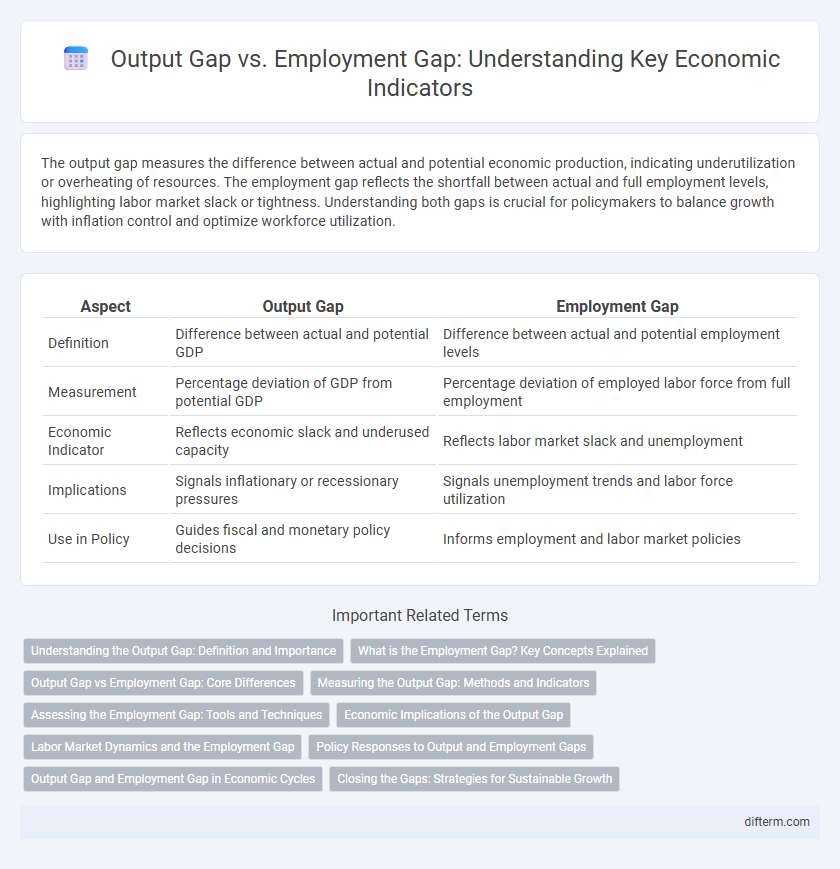The output gap measures the difference between actual and potential economic production, indicating underutilization or overheating of resources. The employment gap reflects the shortfall between actual and full employment levels, highlighting labor market slack or tightness. Understanding both gaps is crucial for policymakers to balance growth with inflation control and optimize workforce utilization.
Table of Comparison
| Aspect | Output Gap | Employment Gap |
|---|---|---|
| Definition | Difference between actual and potential GDP | Difference between actual and potential employment levels |
| Measurement | Percentage deviation of GDP from potential GDP | Percentage deviation of employed labor force from full employment |
| Economic Indicator | Reflects economic slack and underused capacity | Reflects labor market slack and unemployment |
| Implications | Signals inflationary or recessionary pressures | Signals unemployment trends and labor force utilization |
| Use in Policy | Guides fiscal and monetary policy decisions | Informs employment and labor market policies |
Understanding the Output Gap: Definition and Importance
The output gap measures the difference between an economy's actual GDP and its potential GDP, reflecting underused or overheated resources. It is crucial for policymakers to identify economic slack and guide monetary and fiscal interventions to stabilize growth. Understanding the output gap helps predict inflationary pressures and informs decisions on employment and capacity utilization.
What is the Employment Gap? Key Concepts Explained
The employment gap measures the difference between the actual employment level and the maximum sustainable employment level in an economy, reflecting underutilization of labor resources. It highlights the number of people unemployed or underemployed relative to full employment, providing insight into labor market slack and economic inefficiency. Understanding the employment gap helps policymakers design targeted interventions to stimulate job creation and reduce unemployment rates.
Output Gap vs Employment Gap: Core Differences
The output gap measures the difference between actual and potential economic output, reflecting overall productivity shortfalls or surpluses in an economy. The employment gap quantifies the disparity between the actual labor force participation or employment levels and their potential or natural rates, highlighting underutilization of labor resources. While the output gap centers on aggregate economic performance, the employment gap specifically addresses labor market conditions, which may diverge due to changes in productivity, labor force participation, or demographic shifts.
Measuring the Output Gap: Methods and Indicators
Measuring the output gap involves comparing actual GDP with potential GDP, using methods such as production function approaches, statistical filters like the Hodrick-Prescott filter, and econometric models. Key indicators include capacity utilization rates, labor market slack, and productivity trends, which help quantify the difference between an economy's current performance and its optimal level. Accurate estimation of the output gap informs monetary policy decisions by highlighting inflationary pressures or economic slack.
Assessing the Employment Gap: Tools and Techniques
Assessing the employment gap involves analyzing labor market data such as the unemployment rate, labor force participation rate, and underemployment statistics to measure deviations from full employment. Econometric models and Bayesian filtering techniques, like the Kalman filter, help estimate the hidden employment gap by accounting for cyclical fluctuations and structural changes. Advanced tools integrating real-time job vacancy data and wage growth metrics enhance the accuracy of employment gap measurement, supporting targeted economic policy decisions.
Economic Implications of the Output Gap
The output gap measures the difference between actual and potential GDP, directly reflecting underused economic capacity and influencing inflationary pressures. Persistent negative output gaps indicate slack in the economy, leading to higher unemployment and reduced wage growth, thereby impacting consumer spending and overall demand. Policymakers rely on output gap estimates to calibrate monetary and fiscal policies aimed at stabilizing inflation and promoting sustainable employment levels.
Labor Market Dynamics and the Employment Gap
The employment gap highlights the difference between actual employment levels and the labor market's full-employment potential, reflecting underutilized workforce capacity. Labor market dynamics, including job creation rates, labor force participation, and wage flexibility, directly influence the magnitude of the employment gap. Evaluating the employment gap provides deeper insights into economic slack beyond the output gap, informing targeted policy interventions to boost job growth and reduce unemployment.
Policy Responses to Output and Employment Gaps
Policy responses to output gaps often include monetary stimulus such as lowering interest rates to boost aggregate demand and close the production shortfall. Employment gap mitigation focuses on targeted labor market interventions like job training programs, wage subsidies, and unemployment benefits to raise labor force participation. Coordinated fiscal policies that combine demand-side measures with labor market reforms effectively address both output and employment disparities.
Output Gap and Employment Gap in Economic Cycles
The output gap measures the difference between actual and potential economic output, indicating underutilized resources during recessions or overheating in booms. The employment gap captures the disparity between actual employment and full employment, reflecting labor market slack in economic downturns. Both gaps widen in contractions and narrow in expansions, serving as key indicators of cyclical economic health and policy effectiveness.
Closing the Gaps: Strategies for Sustainable Growth
Closing the output gap and employment gap requires targeted fiscal policies and investment in workforce development to boost economic productivity and job creation. Enhancing labor market flexibility and upskilling workers can reduce unemployment and underemployment, aligning actual output closer to potential GDP. Sustainable growth hinges on balancing demand stimulation with structural reforms to increase labor participation and optimize resource allocation.
Output Gap vs Employment Gap Infographic

 difterm.com
difterm.com